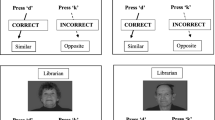Abstract
The Implicit Relational Assessment Procedure (IRAP) has been used for assessing implicit attitudes across different domains. The current study aimed to investigate whether the IRAP is an adequate measure to assess children’s implicit gender-based attitudes toward toys (dolls and toy cars). Although the software parameters used were taken from previous adult studies, children performed successfully in the task. The strongest IRAP effect found was for relations between dolls and girls (i.e., participants responded faster when relating dolls-girls-match than dolls-boys-match). Additionally, children’s response latencies were longer for pairings of dolls and boys than for pairings of toy cars and girls. These findings seem to confirm that the IRAP is sensitive to gender-stereotyped relations established in children and may be a useful tool in providing additional information to complement explicit measures in children’s attitudes.


Similar content being viewed by others
References
Barnes-Holmes, D., Barnes-Holmes, Y., Power, P., Hayden, E., Milne, R., & Stewart, I. (2006). Do you really know what you believe? Developing the Implicit Relational Assessment Procedure (IRAP) as a direct measure of implicit beliefs. The Irish Psychologist, 32(7), 169–177.
Barnes-Holmes, D., Waldron, D., Barnes-Holmes, Y., & Stewart, I. (2009). Testing the validity of the Implicit Relational Assessment Procedure and the Implicit Association Test: measuring attitudes toward Dublin and country life in Ireland. The Psychological Record, 59, 389–406.
Barnes-Holmes, D., Murphy, A., Barnes-Holmes, Y., & Stewart, I. (2010a). The Implicit Relational Assessment Procedure: exploring the impact of private versus public contexts and the response latency criterion on pro-white and anti-black stereotyping among white Irish individuals. The Psychological Record, 60, 43–66.
Barnes-Holmes, D., Murtagh, L., Barnes-Holmes, Y., & Stewart, I. (2010b). Using the implicit association test and the implicit relational assessment procedure to measure attitudes toward meat and vegetables in vegetarians and meat-eaters. The Psychological Record, 60, 287–306.
Baron, A. S., & Banaji, M. R. (2006). The development of implicit attitudes evidence of race evaluations from ages 6 and 10 and adulthood. Psychological Science, 17(1), 53–58. doi:10.1111/j.1467-9280.2005.01664.x.
Blakemore, J. E. O., & Centers, R. E. (2005). Characteristics of boys’ and girls’ toys. Sex Roles, 53, 619–633.
Bortoloti, R., & de Rose, J. C. (2012). Equivalent stimuli are more strongly related after training with delayed matching than after simultaneous matching: a study using the Implicit Relational Assessment Procedure (IRAP). The Psychological Record, 62, 41–54.
Brown, C. S., & Bigler, R. S. (2005). Children’s perceptions of discrimination: a developmental model. Child Development, 76(3), 533–553.
Brown, C. S., Alabi, B. O., Huynh, V. W., & Masten, C. L. (2011). Ethnicity and gender in late childhood and early adolescence: group identity and awareness of bias. Developmental Psychology, 47(2), 463.
Carter, D. B., & Mccloskey, L. A. (1984). Peers and the maintenance of sex-typed behavior: the development of children’s conceptions of cross-gender behavior in their peers. Social Cognition, 2, 294–314.
Chan, G., Barnes-Holmes, D., Barnes-Holmes, Y., & Stewart, I. (2009). Implicit attitudes to work and leisure among North American and Irish individuals: a preliminary study. International Journal of Psychology and Psychological Therapy, 9(3), 317–334.
Cvencek, D., Meltzoff, A. N., & Greenwald, A. G. (2011). Math–gender stereotypes in elementary school children. Child Development, 82(3), 766–779. doi:10.1111/j.1467-8624.2010.01529.x.
Dunham, Y., Baron, A. S., & Banaji, M. R. (2006). From American city to Japanese village: a cross-cultural investigation of implicit race attitudes. Child Development, 77(5), 1268–1281. doi:10.1111/j.1467-8624.2006.00933.x.
Friedman, C. K., Leaper, C., & Bigler, R. (2007). Do mothers’ gender related attitudes or comments predict young children’s gender beliefs? Parenting: Science and Practice, 7, 1–15.
Greenwald, A. G., Mcghee, D. E., & Schwartz, J. L. K. (1998). Measuring individual differences in implicit cognition: the Implicit Association Test. Journal of Personality and Social Psychology, 74, 1464–1480.
Langlois, J. H., & Downs, A. C. (1980). Mothers, fathers, and peers as socialization agents of sex-typed play behaviors in young children. Child Development, 51, 1217–1247.
Leaper, C. (2011). Research in developmental psychology on gender and relationships: Reflections on the past and looking into the future. British Journal of Developmental Psychology, 29(2), 347–356.
Leaper, C., & Bigler, R. S. (2011). Gender. In M. K. Underwood & L. S. Rosen (Eds.), Social development: Relationships in infancy, childhood, and adolescence (pp. 289–315). New York: Guilford Press.
Lytton, H., & Romney, D. M. (1991). Parents’ differential socialization of boys and girls: a meta-analysis. Psychological Bulletin, 2, 267–296.
Mckenna, I., Barnes-Holmes, D., Barnes-Holmes, Y., & Stewart, I. (2007). Testing the fake-ability of the Implicit Relational Assessment Procedure (IRAP): the first study. International Journal of Psychology and Psychological Therapy, 7(2), 123–138.
Nicholson, E., & Barnes-Holmes, D. (2012). The Implicit Relational Assessment Procedure (IRAP) as a measure of spider fear. Psychological Record, 62, 263–278.
O’Toole, C., Barnes-Holmes, D., Murphy, C., O’Connor, J., & Barnes-Holmes, Y. (2009). Relational flexibility and human intelligence: extending the remit of Skinner’s Verbal Behavior. International Journal of Psychology and Psychological Therapy, 9, 1–17.
Pahlke, E., Bigler, R. S., & Suizzo, M. A. (2012). Relations between colorblind socialization and children’s racial bias: evidence from European American mothers and their preschool children. Child Development, 83, 1164–1179. doi:10.1111/j.1467-8624.2012.01770.x.
Power, P., Barnes-Holmes, D., Barnes-Holmes, Y., & Stewart, I. (2009). The Implicit Relational Assessment Procedure (IRAP) as a measure of implicit relative preferences: a first study. The Psychological Record, 59, 621–640.
Roddy, S., Stewart, I., & Barnes-Holmes, D. (2010). Anti-fat, pro-slim, or both? Using two reaction time based measures to assess implicit attitudes to the slim and overweight. Journal of Health Psychology, 15, 416–425.
Smith, P. (2010). Children and play: Understanding children’s worlds. Oxford: Wiley-Blackwell.
Stockwell, F. M., Walker, D. J., & Eshleman, J. W. (2010). Measures of implicit and explicit attitudes toward mainstream and BDSM sexual terms using the IRAP and questionnaire with BDSM/fetish and student participants. The Psychological Record, 60, 307–324.
Timko, C. A., England, E. L., Herbert, J. D., & Forman, E. M. (2010). The Implicit Relational Assessment Procedure as a measure of self-esteem. The Psychological Record, 60, 679–698.
Wanderlind, F., Martins, G. D. F., Hansen, J., Macarini, S. M., & Vieira, M. L. (2006). Diferenças de gênero no brincar de crianças pré-escolares e escolares na brinquedoteca [Gender differences in play of prescholar and scholar’s children at toy-library]. Paidéia, 16(34), 263–273.
Author information
Authors and Affiliations
Corresponding author
Additional information
The first author was supported by FAPESP during the development of this research (#2009/04736-6) and by CAPES during the preparation of the manuscript. Renato Bortoloti was supported by FAPESP through a Young Investigator grant (#2011/50561-3). This study is part of the research program of Instituto Nacional de Ciência e Tecnologia sobre Comportamento, Cognição e Ensino (Deisy G. de Souza, Chairperson), supported by grants from the Brazilian National Research Council–CNPq (Grant #573972/2008-7) and FAPESP (Grant #08/57705-8). We thank Julio C. de Rose for his ongoing and invaluable support. Finally, we thank Dr. Dermot Barnes-Holmes and two anonymous reviewers for their helpful suggestions.
Rights and permissions
About this article
Cite this article
Rabelo, L.Z., Bortoloti, R. & Souza, D.H. Dolls are for Girls and Not for Boys: Evaluating the Appropriateness of the Implicit Relational Assessment Procedure for School-Age Children. Psychol Rec 64, 71–77 (2014). https://doi.org/10.1007/s40732-014-0006-2
Published:
Issue Date:
DOI: https://doi.org/10.1007/s40732-014-0006-2




